Who Are the Elderly? Aging in Society
Overview
- Understand the difference between senior age groups (young-old, middle-old, and old-old)
- Describe the “graying of the United States” as the population experiences increased life expectancies
- Examine aging as a global issue
Think of U.S. movies and television shows you have watched recently. Did any of them feature older actors and actresses? What roles did they play? How were these older actors portrayed? Were they cast as main characters in a love story? Or were they cast as grouchy old people?
Many media portrayals of the elderly reflect negative cultural attitudes toward aging. In the United States, society tends to glorify youth and associate it with beauty and sexuality. In comedies, the elderly are often associated with grumpiness or hostility. Rarely do the roles of older people convey the fullness of life experienced by seniors—as employees, lovers, or the myriad roles they have in real life. What values does this reflect?
One hindrance to society’s fuller understanding of aging is that people rarely understand the process of aging until they reach old age themselves. (As opposed to childhood, for instance, which we can all look back on.) Therefore, myths and assumptions about the elderly and aging are common. Many stereotypes exist surrounding the realities of being an older adult. While individuals often encounter stereotypes associated with race and gender and are thus more likely to think critically about them, many people accept age stereotypes without question (Levy 2002). Each culture has a certain set of expectations and assumptions about aging, all of which are part of our socialization.
While the landmarks of maturing into adulthood are a source of pride, signs of natural aging can be cause for shame or embarrassment. Some people try to fight off the appearance of aging with cosmetic surgery. Although many seniors report that their lives are more satisfying than ever, and their self-esteem is stronger than when they were young, they are still subject to cultural attitudes that make them feel invisible and devalued.
Gerontology is a field of science that seeks to understand the process of aging and the challenges encountered as seniors grow older. Gerontologists investigate age, aging, and the aged. Gerontologists study what it is like to be an older adult in a society and the ways that aging affects members of a society. As a multidisciplinary field, gerontology includes the work of medical and biological scientists, social scientists, and even financial and economic scholars.
Social gerontology refers to a specialized field of gerontology that examines the social (and sociological) aspects of aging. Researchers focus on developing a broad understanding of the experiences of people at specific ages, such as mental and physical wellbeing, plus age-specific concerns such as the process of dying. Social gerontologists work as social researchers, counselors, community organizers, and service providers for older adults. Because of their specialization, social gerontologists are in a strong position to advocate for older adults.
Scholars in these disciplines have learned that “aging” reflects not only the physiological process of growing older but also our attitudes and beliefs about the aging process. You’ve likely seen online calculators that promise to determine your “real age” as opposed to your chronological age. These ads target the notion that people may “feel” a different age than their actual years. Some sixty-year-olds feel frail and elderly, while some eighty-year-olds feel sprightly.
Equally revealing is that as people grow older they define “old age” in terms of greater years than their current age (Logan 1992). Many people want to postpone old age and regard it as a phase that will never arrive. Some older adults even succumb to stereotyping their own age group (Rothbaum 1983).
In the United States, the experience of being elderly has changed greatly over the past century. In the late 1800s and early 1900s, many U.S. households were home to multigenerational families, and the experiences and wisdom of elders was respected. They offered wisdom and support to their children and often helped raise their grandchildren (Sweetser 1984).
Multigenerational U.S. families began to decline after World War II, and their numbers reached a low point around 1980, but they are on the rise again. In fact, a 2010 Pew Research Center analysis of census data found that multigenerational families in the United States have now reached a record high. The 2008 census data indicated that 49 million U.S. families, 16.1 percent of the country's total population, live in a family household with at least two adult generations—or a grandparent and at least one other generation.
Attitudes toward the elderly have also been affected by large societal changes that have happened over the past 100 years. Researchers believe industrialization and modernization have contributed greatly to lowering the power, influence, and prestige the elderly once held.
The elderly have both benefitted and suffered from these rapid social changes. In modern societies, a strong economy created new levels of prosperity for many people. Healthcare has become more widely accessible, and medicine has advanced, which allows the elderly to live longer. However, older people are not as essential to the economic survival of their families and communities as they were in the past.
Studying Aging Populations
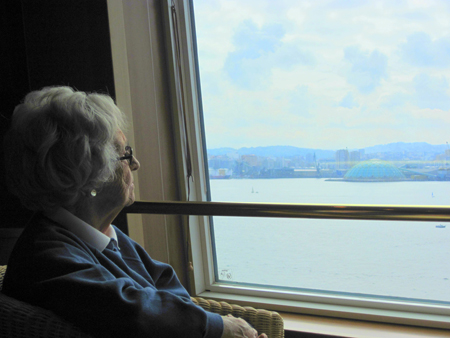
Since its creation in 1790, the U.S. Census Bureau has been tracking age in the population. Age is an important factor to analyze with accompanying demographic figures, such as income and health. The population pyramid below shows projected age distribution patterns for the next several decades.
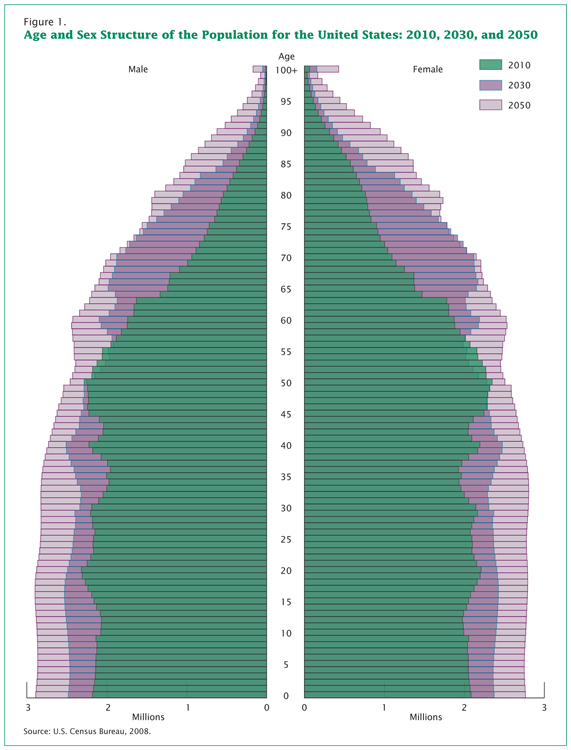
Statisticians use data to calculate the median age of a population, that is, the number that marks the halfway point in a group’s age range. In the United States, the median age is about forty (U.S. Census Bureau 2010). That means that about half of the people in the United States are under forty and about half are over forty. This median age has been increasing, which indicates the population as a whole is growing older.
A cohort is a group of people who share a statistical or demographic trait. People belonging to the same age cohort were born in the same time frame. Understanding a population’s age composition can point to certain social and cultural factors and help governments and societies plan for future social and economic challenges.
Sociological studies on aging might help explain the difference between Native American age cohorts and the general population. While Native American societies have a strong tradition of revering their elders, they also have a lower life expectancy because of lack of access to healthcare and high levels of mercury in fish, which is a traditional part of their diet.
Phases of Aging: The Young-Old, Middle-Old, and Old-Old
In the United States, all people over eighteen years old are considered adults, but there is a large difference between a person who is twenty-one years old and a person who is forty-five years old. More specific breakdowns, such as “young adult” and “middle-aged adult,” are helpful. In the same way, groupings are helpful in understanding the elderly. The elderly are often lumped together to include everyone over the age of sixty-five. But a sixty-five-year-old’s experience of life is much different from a ninety-year-old’s.
The United States’ older adult population can be divided into three life-stage subgroups: the young-old (approximately sixty-five to seventy-four years old), the middle-old (ages seventy-five to eighty-four years old), and the old-old (over age eighty-five). Today’s young-old age group is generally happier, healthier, and financially better off than the young-old of previous generations. In the United States, people are better able to prepare for aging because resources are more widely available.
Also, many people are making proactive quality-of-life decisions about their old age while they are still young. In the past, family members made care decisions when an elderly person reached a health crisis, often leaving the elderly person with little choice about what would happen. The elderly are now able to choose housing, for example, that allows them some independence while still providing care when it is needed. Living wills, retirement planning, and medical power of attorney are other concerns that are increasingly handled in advance.
The Graying of the United States
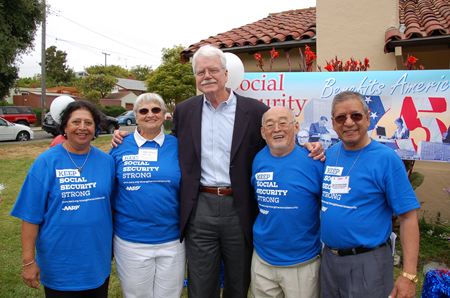
What does it mean to be elderly? Some define it as an issue of physical health, while others simply define it by chronological age. The U.S. government, for example, typically classifies people aged sixty-five years old as elderly, at which point citizens are eligible for federal benefits such as Social Security and Medicare. The World Health Organization has no standard, other than noting that sixty-five years old is the commonly accepted definition in most core nations, but it suggests a cut-off somewhere between fifty and fifty-five years old for semi-peripheral nations, such as those in Africa (World Health Organization 2012). AARP (formerly the American Association of Retired Persons) cites fifty as the eligible age of membership. It is interesting to note AARP’s name change; by taking the word “retired” out of its name, the organization can broaden its base to any older people in the United States, not just retirees. This is especially important now that many people are working to age seventy and beyond.
There is an element of social construction, both local and global, in the way individuals and nations define who is elderly; that is, the shared meaning of the concept of elderly is created through interactions among people in society. This is exemplified by the truism that you are only as old as you feel.
Demographically, the U.S. population over sixty-five years old increased from 3 million in 1900 to 33 million in 1994 (Hobbs 1994) and to 36.8 million in 2010 (U.S. Census Bureau 2011c). This is a greater than tenfold increase in the elderly population, compared to a mere tripling of both the total population and of the population under sixty-five years old (Hobbs 1994). This increase has been called “the graying of America,” a term that describes the phenomenon of a larger and larger percentage of the population getting older and older. There are several reasons why the United States is graying so rapidly. One of these is life expectancy: the average number of years a person born today may expect to live. When we review Census Bureau statistics grouping the elderly by age, it is clear that in the United States, at least, we are living longer. In 2010, there were about 80,000 centenarians in the United States alone. They make up one of the fastest-growing segments of the population (Boston University School of Medicine 2014).
People over ninety years of age now account for 4.7 percent of the older population, defined as age sixty-five or above; this percentage is expected to reach 10 percent by the year 2050 (U.S. Census Bureau 2011). As of 2013, the U.S. Census Bureau reports that 14.1 percent of the total U.S. population is sixty-five years old or older.
It is interesting to note that not all people in the United States age equally. Most glaring is the difference between men and women; as Figure shows, women have longer life expectancies than men. In 2010, there were ninety sixty-five-year-old men per one hundred sixty-five-year-old women. However, there were only eighty seventy-five-year-old men per one hundred seventy-five-year-old women, and only sixty eighty-five-year-old men per one hundred eighty-five-year-old women. Nevertheless, as the graph shows, the sex ratio actually increased over time, indicating that men are closing the gap between their life spans and those of women (U.S. Census Bureau 2010).
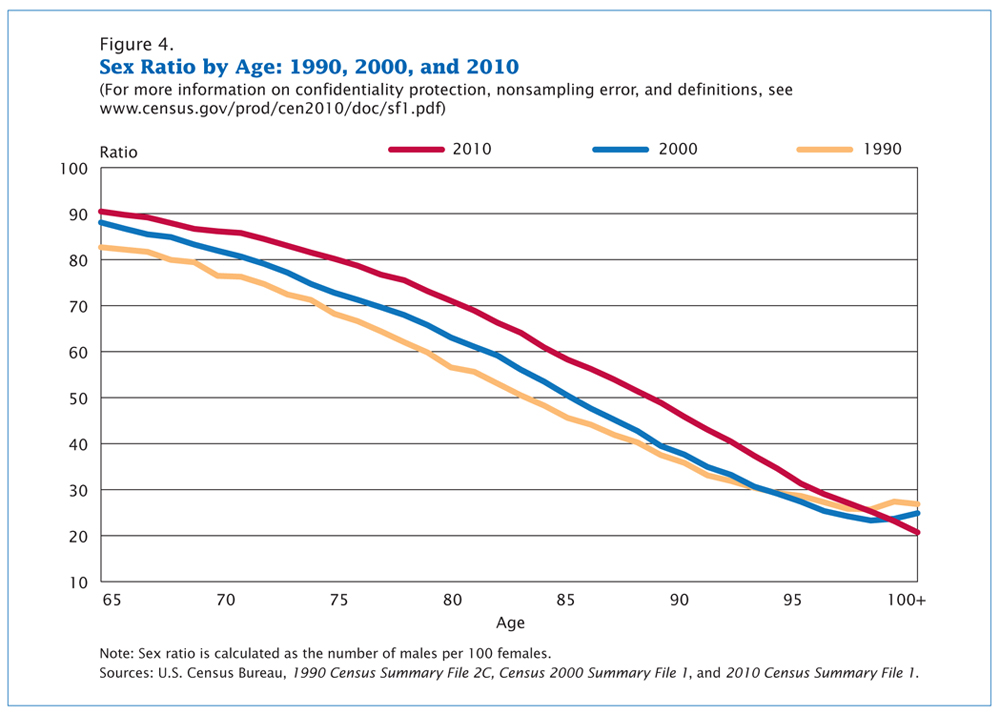
Baby Boomers
Of particular interest to gerontologists today is the population of baby boomers, the cohort born between 1946 and 1964 and now reaching their 60s. Coming of age in the 1960s and early 1970s, the baby boom generation was the first group of children and teenagers with their own spending power and therefore their own marketing power (Macunovich 2000). As this group has aged, it has redefined what it means to be young, middle-aged, and now old. People in the boomer generation do not want to grow old the way their grandparents did; the result is a wide range of products designed to ward off the effects—or the signs—of aging. Previous generations of people over sixty-five were “old.” Baby boomers are in “later life” or “the third age” (Gilleard and Higgs 2007).
The baby boom generation is the cohort driving much of the dramatic increase in the over-sixty-five population. Figure shows a comparison of the U.S. population by age and gender between 2000 and 2010. The biggest bulge in the pyramid (representing the largest population group) moves up the pyramid over the course of the decade; in 2000, the largest population group was age thirty-five to fifty-five. In 2010, that group was age forty-five to sixty-five, meaning the oldest baby boomers were just reaching the age at which the U.S. Census considers them elderly. In 2020, we can predict, the baby boom bulge will continue to rise up the pyramid, making the largest U.S. population group between sixty-five and eighty-five years old.
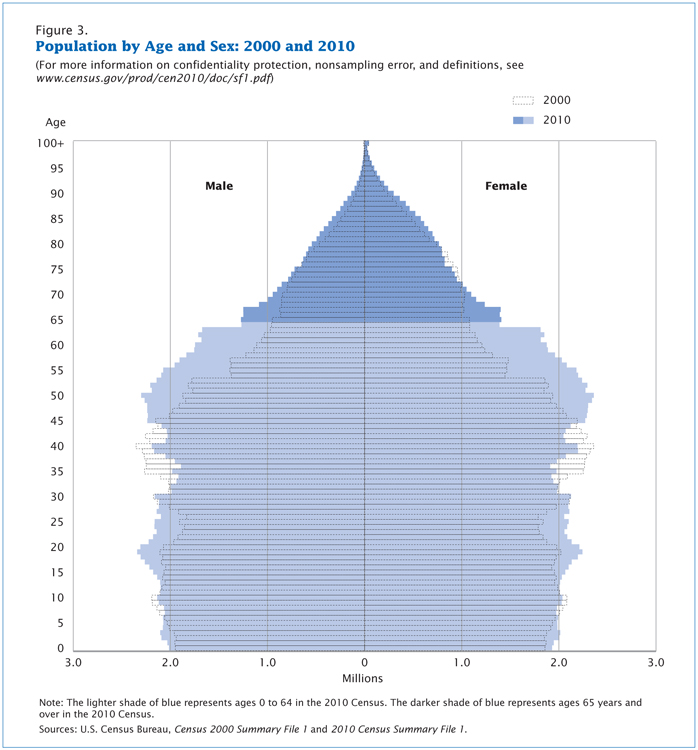
This aging of the baby boom cohort has serious implications for our society. Healthcare is one of the areas most impacted by this trend. For years, hand-wringing has abounded about the additional burden the boomer cohort will place on Medicare, a government-funded program that provides healthcare services to people over sixty-five years old. And indeed, the Congressional Budget Office’s 2008 long-term outlook report shows that Medicare spending is expected to increase from 3 percent of gross domestic product (GDP) in 2009 to 8 percent of GDP in 2030, and to 15 percent in 2080 (Congressional Budget Office 2008).
Certainly, as boomers age, they will put increasing burdens on the entire U.S. healthcare system. A study from 2008 indicates that medical schools are not producing enough medical professionals who specialize in treating geriatric patients (Gerontological Society of America 2008). However, other studies indicate that aging boomers will bring economic growth to the healthcare industries, particularly in areas like pharmaceutical manufacturing and home healthcare services (Bierman 2011). Further, some argue that many of our medical advances of the past few decades are a result of boomers’ health requirements. Unlike the elderly of previous generations, boomers do not expect that turning sixty-five means their active lives are over. They are not willing to abandon work or leisure activities, but they may need more medical support to keep living vigorous lives. This desire of a large group of over-sixty-five-year-olds wanting to continue with a high activity level is driving innovation in the medical industry (Shaw).
The economic impact of aging boomers is also an area of concern for many observers. Although the baby boom generation earned more than previous generations and enjoyed a higher standard of living, they also spent their money lavishly and did not adequately prepare for retirement. According to a 2008 report from the McKinsey Global Institute, approximately two-thirds of early boomer households have not accumulated enough savings to maintain their lifestyles. This will have a ripple effect on the economy as boomers work and spend less (Farrel et al. 2008).
Just as some observers are concerned about the possibility of Medicare being overburdened, Social Security is considered to be at risk. Social Security is a government-run retirement program funded primarily through payroll taxes. With enough people paying into the program, there should be enough money for retirees to take out. But with the aging boomer cohort starting to receive Social Security benefits and fewer workers paying into the Social Security trust fund, economists warn that the system will collapse by the year 2037. A similar warning came in the 1980s; in response to recommendations from the Greenspan Commission, the retirement age (the age at which people could start receiving Social Security benefits) was raised from sixty-two to sixty-seven and the payroll tax was increased. A similar hike in retirement age, perhaps to seventy, is a possible solution to the current threat to Social Security (Reuteman 2010).
Aging around the World
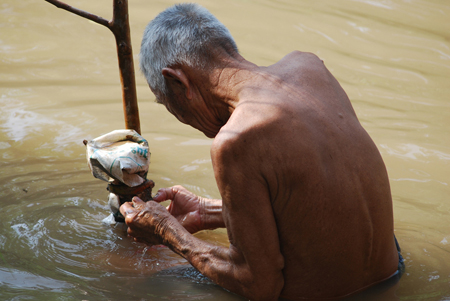
From 1950 to approximately 2010, the global population of individuals age sixty-five and older increased by a range of 5–7 percent (Lee 2009). This percentage is expected to increase and will have a huge impact on the dependency ratio: the number of nonproductive citizens (young, disabled, or elderly) to productive working citizens (Bartram and Roe 2005). One country that will soon face a serious aging crisis is China, which is on the cusp of an “aging boom”— a period when its elderly population will dramatically increase. The number of people above age sixty in China today is about 178 million, which amounts to 13.3 percent of its total population (Xuequan 2011). By 2050, nearly a third of the Chinese population will be age sixty or older, which will put a significant burden on the labor force and impacting China’s economic growth (Bannister, Bloom, and Rosenberg 2010).
As healthcare improves and life expectancy increases across the world, elder care will be an emerging issue. Wienclaw (2009) suggests that with fewer working-age citizens available to provide home care and long-term assisted care to the elderly, the costs of elder care will increase.
Worldwide, the expectation governing the amount and type of elder care varies from culture to culture. For example, in Asia the responsibility for elder care lies firmly on the family (Yap, Thang, and Traphagan 2005). This is different from the approach in most Western countries, where the elderly are considered independent and are expected to tend to their own care. It is not uncommon for family members to intervene only if the elderly relative requires assistance, often due to poor health. Even then, caring for the elderly is considered voluntary. In the United States, decisions to care for an elderly relative are often conditionally based on the promise of future returns, such as inheritance or, in some cases, the amount of support the elderly provided to the caregiver in the past (Hashimoto 1996).
These differences are based on cultural attitudes toward aging. In China, several studies have noted the attitude of filial piety (deference and respect to one’s parents and ancestors in all things) as defining all other virtues (Hsu 1971; Hamilton 1990). Cultural attitudes in Japan prior to approximately 1986 supported the idea that the elderly deserve assistance (Ogawa and Retherford 1993). However, seismic shifts in major social institutions (like family and economy) have created an increased demand for community and government care. For example, the increase in women working outside the home has made it more difficult to provide in-home care to aging parents, which leads to an increase in the need for government-supported institutions (Raikhola and Kuroki 2009).
In the United States, by contrast, many people view caring for the elderly as a burden. Even when there is a family member able and willing to provide for an elderly family member, 60 percent of family caregivers are employed outside the home and are unable to provide the needed support. At the same time, however, many middle-class families are unable to bear the financial burden of “outsourcing” professional healthcare, resulting in gaps in care (Bookman and Kimbrel 2011). It is important to note that even within the United States not all demographic groups treat aging the same way. While most people in the United States are reluctant to place their elderly members into out-of-home assisted care, demographically speaking, the groups least likely to do so are Latinos, African Americans, and Asians (Bookman and Kimbrel 2011).
Globally, the United States and other core nations are fairly well equipped to handle the demands of an exponentially increasing elderly population. However, peripheral and semi-peripheral nations face similar increases without comparable resources. Poverty among elders is a concern, especially among elderly women. The feminization of the aging poor, evident in peripheral nations, is directly due to the number of elderly women in those countries who are single, illiterate, and not a part of the labor force (Mujahid 2006).
In 2002, the Second World Assembly on Aging was held in Madrid, Spain, resulting in the Madrid Plan, an internationally coordinated effort to create comprehensive social policies to address the needs of the worldwide aging population. The plan identifies three themes to guide international policy on aging: 1) publically acknowledging the global challenges caused by, and the global opportunities created by, a rising global population; 2) empowering the elderly; and 3) linking international policies on aging to international policies on development (Zelenev 2008).
The Madrid Plan has not yet been successful in achieving all its aims. However, it has increased awareness of the various issues associated with a global aging population, as well as raising the international consciousness to the way that the factors influencing the vulnerability of the elderly (social exclusion, prejudice and discrimination, and a lack of socio-legal protection) overlap with other developmental issues (basic human rights, empowerment, and participation), leading to an increase in legal protections (Zelenev 2008).
Summary
The social study of aging uses population data and cohorts to predict social concerns related to aging populations. In the United States, the population is increasingly older (called “the graying of the United States”), especially due to the baby boomer segment. Global studies on aging reveal a difference in life expectancy between core and peripheral nations as well as a discrepancy in nations’ preparedness for the challenges of increasing elderly populations.
Section Quiz
In most countries, elderly women ______ than elderly men.
- are mistreated less
- live a few years longer
- suffer fewer health problems
- deal with issues of aging better
Hint:
B
America’s baby boomer generation has contributed to all of the following except:
- Social Security’s vulnerability
- improved medical technology
- Medicaid being in danger of going bankrupt
- rising Medicare budgets
Hint:
C
The measure that compares the number of men to women in a population is ______.
- cohort
- sex ratio
- baby boomer
- disengagement
Hint:
B
The “graying of the United States” refers to ________.
- the increasing percentage of the population over sixty-five years old
- faster aging due to stress
- dissatisfaction with retirement plans
- increased health problems such as Alzheimer’s
Hint:
A
What is the approximate median age of the United States?
- eighty-five
- sixty-five
- thirty-seven
- eighteen
Hint:
C
Short Answer
Baby boomers have been called the “Me Generation.” Do you know any baby boomers? In what way do they exemplify their generation?
What social issues involve age disaggregation (breakdowns into groups) of a population? What kind of sociological studies would consider age an important factor?
Conduct a mini-census by counting the members of your extended family, and emphasize age. Try to include three or four generations, if possible. Create a table and include total population plus percentages of each generation. Next, begin to analyze age patterns in your family. What issues are important and specific to each group? What trends can you predict about your own family over the next ten years based on this census? For example, how will family members’ needs and interests and relationships change the family dynamic?
Further Research
Gregory Bator founded the television show Graceful Aging and then developed a web site offering short video clips from the show. The purpose of Graceful Aging is to both inform and entertain, with clips on topics such as sleep, driving, health, safety, and legal issues. Bator, a lawyer, works on counseling seniors about their legal needs. Log onto Graceful Aging for a visual understanding of aging: http://openstaxcollege.org/l/graceful_aging
References
Bannister, Judith, David E. Bloom, and Larry Rosenberg. 2010. Population Aging and Economic Growth in China. Cambridge, MA: The Program on the Global Demography of Aging.
Bartram, L., and B. Roe. 2005. “Dependency Ratios: Useful Policy-Making Tools?” Geriatrics & Gerontology International 5:224–228.
Bierman, Libby. 2011. “The Baby Boom = The BIG Boom in Healthcare.” Forbes, July 22. Retrieved January 31, 2012 (http://www.forbes.com/sites/sageworks/2011/07/22/the-baby-boom-the-big-boom-in-healthcare/).
Bookman, Ann, and Delia Kimbrel. 2011. “Families and Elder Care in the Twenty-First Century.” The Future of Children 21:117–140.
Bostrom, Josh. 2005. “Aging Baby Boomers Will Drive Health-Care Innovation.” Infoworld. Retrieved January 31, 2012 (http://www.infoworld.com/t/business/aging-baby-boomers-will-drive-health-care-innovation-054).
Congressional Budget Office. 2008. “Long-Term Outlook for Medicare, Medicaid and Total Health Care Spending.” Retrieved January 31, 2012 (http://www.cbo.gov/ftpdocs/102xx/doc10297/Chapter2.5.1.shtml).
Farrel, Diana, David Court, Eric Beinhocker, John Forsyth, Ezra Greenberg, Suruchi Shukla, Jonathan Ablett, and Geoffrey Greene. 2008. Talkin' 'Bout My Generation: The Economic Impact of Aging US Baby Boomers. McKinsey Global Institute. Retrieved February 12, 2012 (http://www.mckinsey.com/Insights/MGI/Research/Americas/Talkin_bout_my_generation).
Gerontological Society of America. 2008. “Baby Boomer Health Care Crisis Looms.” Science Daily, April 17. Retrieved January 31, 2012 (http://www.sciencedaily.com/releases/2008/04/080417111300.htm).
Gilleard, Chris, and Paul Higgs. 2007. “The Third Age and the Baby Boomers: Two Approaches to the Social Structuring of Later Life.” International Journal of Ageing and Later Life 2(2):13–30.
Hamilton, Gary. 1990. “Patriarchy, Patrimonialism, and Filial Piety: A Comparison of China and Western Europe.” British Journal of Sociology 41:77–104.
Hashimoto, Akiko. 1996. The Gift of Generations: Japanese and American Perspectives on Aging and the Social Contract. New York: Cambridge University Press.
Hobbs, Frank. 1994. “The Elderly Population.” Population Profile of the United States. Retrieved January 28, 2012 (http://www.census.gov/population/www/pop-profile/elderpop.html).
Hsu, Francis. 1971. “Filial Piety in Japan and China: Borrowing, Variation and Significance.” Journal of Comparative Family Studies 2:67–74.
Lee, Mary. 2009. “Trends in Global Population Growth.” Research Starters Sociology: Academic Topic Overview. Retrieved January 28, 2012 from (http://www.ebscohost.com/academic/academic-search-premier).
Levy, Becca R., Martin D. Slade, Suzanne R. Kunkel, and Stanislav V. Kasl, 2002. “Longevity Increased by Positive Self-perceptions of Aging.” Journal of Personality and Social Psychology 83(2):261–270.
Logan, J.R., R. Ward, and G. Spitze. 1992. “As Old as You Feel: Age Identity in Middle and Later Life.” Sociological Forces 71:451–67.
Macunovich, Diane J. 2000. The Baby Boomers. New York: Barnard College Department of Economics.
Mujahid, G. 2006. “Population Ageing in East and South-East Asia: Current Situation and Emerging Challenges.” Papers in Population Ageing No.1. New York: United Nations Population Fund. Retrieved January 28, 2012 (http://www.eldis.org/assets/Docs/23355.html).
Native News Network. 2011. “Age Distribution: AIAN Compared to Total US.” Retrieved January 22, 2012 (http://www.nativenewsnetwork.com/native-youth-count.html).
Ogawa, Naohiro, and Robert Retherford. 1993. “Care of the Elderly in Japan: Changing Norms and Expectations.” Journal of Marriage and the Family 55:585–597.
Pew Research Center. 2010. “The Return of the Multi-Generational Family Household.” Pew Research Social & Demographic Trends; Section I. Retrieved November 1, 2014 (http://www.pewsocialtrends.org/2010/03/18/the-return-of-the-multi-generational-family-household/).
Population Fund. Retrieved January 28, 2012 (http://www.eldis.org/assets/Docs/23355.html).
Raikhola, Pushkar Singh, and Yasuhiro Kuroki. 2009. “Aging and Elderly Care Practice in Japan: Main Issues, Policy and Program Perspective; What Lessons Can Be Learned from Japanese Experiences?” Dhaulagiri: Journal of Sociology & Anthropology 3:41–82.
Reuteman, Rob. 2010. Will Baby Boomers Bankrupt Social Security? Retrieved January 31, 2012 (http://www.cnbc.com/id/34941334/Will_Baby_Boomers_Bankrupt_Social_Security).
Rothbaum, F. 1983. “Aging and Age Stereotypes.” Social Cognition 2:171–84.
Shaw, Gina. “Hip and Knee Replacements on the Rise.” Web MD. Retrieved February 13, 2012 (http://arthritis.webmd.com/features/hip-knee-replacements-rise).
Sweetser, Dorian Apple. 1984. “Love and Work: Intergenerational Household Composition in the U. S. in 1900.” Journal of Marriage and the Family 46(2):289–293.
U.S. Census Bureau. 2013. “State and County Facts: USA Quick Facts.” US Census Bureau. Retrieved November 1, 2014 (http://quickfacts.census.gov/qfd/states/00000.html).
U.S. Census Bureau. 2011a. “Age and Sex Composition 2010.” 2010 Census Briefs, May. Retrieved February 13, 2012 (http://www.census.gov/prod/cen2010/briefs/c2010br-03.pdf).
U.S. Census Bureau. 2011b. “The Older Population: 2010.” 2010 Census Briefs, November. Retrieved December 13, 2011 (http://0-www.census.gov.iii-server.ualr.edu/prod/cen2010/briefs/c2010br-09.pdf).
U.S. Census Bureau. 2011c. “Population.” The 2012 Statistical Abstract. Retrieved January 28, 2012 (http://www.census.gov/compendia/statab/cats/population.html).
Werner, Carrie. 2011. “The Older Population: 2010.” U.S. Census Bureau. Retrieved January 28, 2012 (http://www.census.gov/prod/cen2010/briefs/c2010br-09.pdf).
Wiencaw, Ruth. 2009. “Caring for the Elderly in America.” Research Starters. Retrieved January 28, 2012 (http://www.ebscohost.com/academic/academic-search-premier).
World Health Organization. 2012. “Definition of an Older or Elderly Person.” Retrieved January 28, 2012 (http://www.who.int/healthinfo/survey/ageingdefnolder/en/index.html).
Xuequan, Mu. 2011. “Premier Wen Join Nursing Home Seniors to Celebrate Mid-Autumn Festival.” Retrieved February 12, 2012 (http://news.xinhuanet.com/english2010/china/2011-09/13/c_131134367.htm).
Yap, Mui Teng, Leng Leng Thang, and John W. Traphagan. 2005. “Introduction: Aging in Asia—Perennial Concerns on Support and Caring for the Old.” Journal of Cross-Cultural Gerontology 20:257–267.
Zelenev, Sergei. 2008. “Regional Dimensions of the Ageing Situation.” The United Nations. Retrieved January 28, 2012 (http://social.un.org/index/Ageing/Resources/PapersandPublications.aspx).